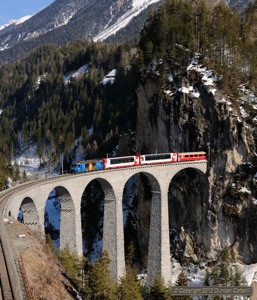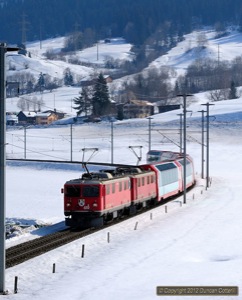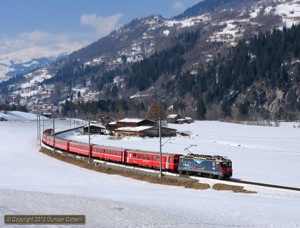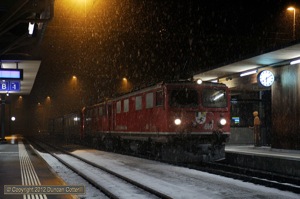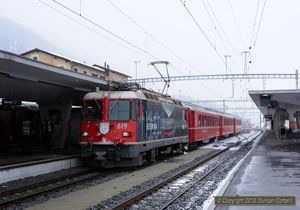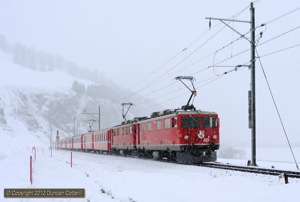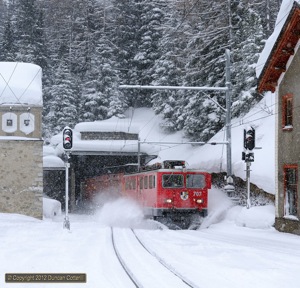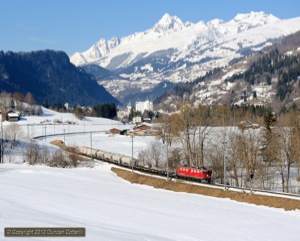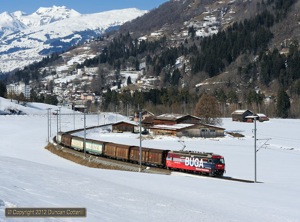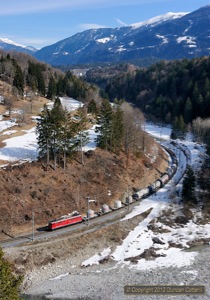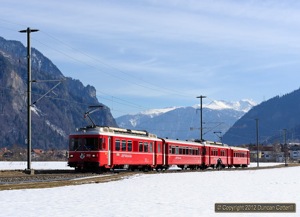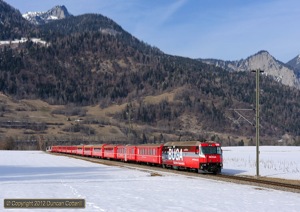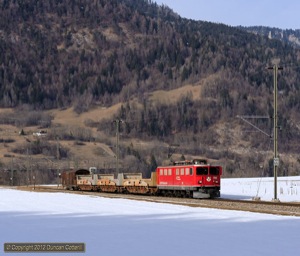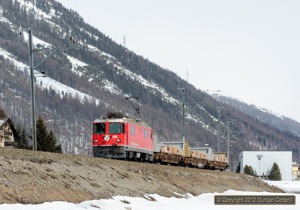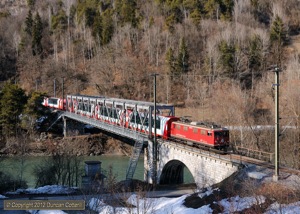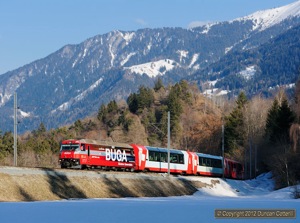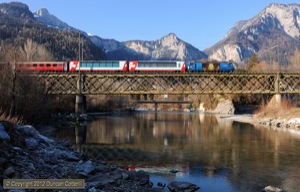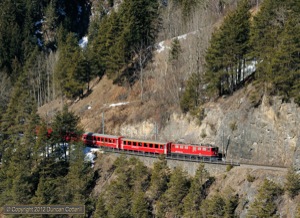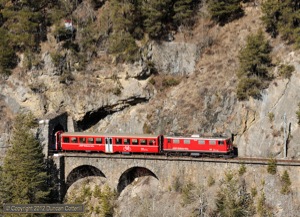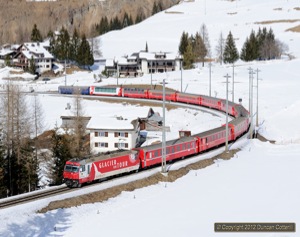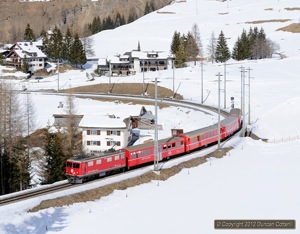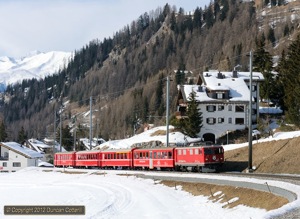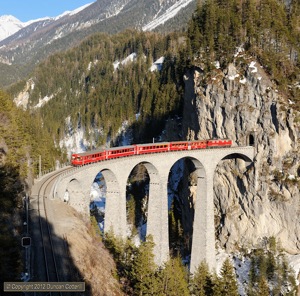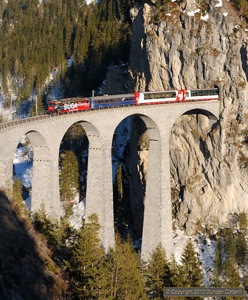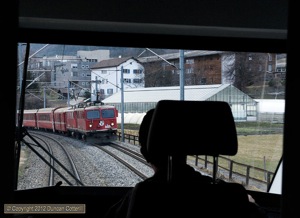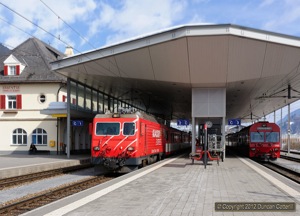RhB Ge4/4i's Last Stand?
03 - 11 March 2012
Report by Duncan Cotterill
Introduction
I had no intention of doing a winter trip to the RhB this year but the continued use of the venerable Ge4/4is, the emergence of Ge4/4iii 644 in all over red livery and the opportunity to get away for the last week of the winter timetable all conspired to force me into it.
This section of the report summarises what was seen. For train by train details with loco numbers etc, go to the Day by Day pages.
Class by Class
Ge4/4i
The RhB’s oldest main line class dates back to 1947 and appeared to have lost all its regular duties in March 2011, so it was a very pleasant surprise to find a Ge4/4i duty in the Winter 2011/2012 diagrams. A single loco was booked to work a couple of freight trips (Landquart to Ilanz and Jenaz) on weekdays and the additional Bergün – Preda Schittelzug turn at weekends.
In practice the last three locos in traffic, 603, 605 and 610, were far more active, covering Glacier Expresses and workings that took them to Disentis, Scuol-Tarasp, St.Moritz and Arosa at various times during my stay, usually on passenger trains. The Shlittelzüge were more erratic due to the sledge run being closed due to avalanche risk until the last couple of days. On Saturday 10 March, the last day of the Winter timetable, 610 worked the trains. Occasionally one would work the Ilanz goods when they didn’t have more glamorous work but the Jenaz part of the turn never seemed to run.
The Spring 2012 diagrams don’t have any work for the Ge4/4is and it remains to be seen if the survivors will be as active again, or even whether they will survive. The RhB has a habit of scrapping locos within days of withdrawal and that has been the fate of the rest of the class, apart from 602, which was dispatched to Luzern Transport Museum during my visit.
Ge4/4ii
These locos work passenger trains on the routes from Scuol-Tarasp to Disentis and Pontresina as well as a few freights and odd early morning passengers. In general terms, they monopolised workings on the two routes mentioned and rarely appeared elsewhere on passenger work.
The one notable exception was that 624 covered one of the Ge4/4iii turns on the Landquart – Davos – Filisur route for several days towards the beginning of my stay.
The class was more active than expected on freight work often deputising for the Ge4/4i on the Ilanz goods and once substituting for a Ge6/6ii on a Landquart – Disentis goods. They also worked a Pontresina – Serneus freight conveying swap bodies on several days.
Another of the class has been painted in a stupid advertising livery, 633 now advertises Romansch Radio but looks more like it’s suffered a bad dose of graffiti.
Ge4/4iii
RhB’s most modern locos are diagrammed to work all Chur – St.Moritz passengers, two of the five Landquart – Davos – Filisur passenger turns and the Selfranga – Sagliains car shuttles through the Vereina Tunnel. On busy days for the car shuttles, all twelve locos are required in use. However, 644 (the one I most wanted to photograph) was out of action for the whole period of my visit and a Ge4/4ii substituted by covering one of the Davos turns for a few days.
Allocation of locos to duties was remarkably stable with the only change being when 646 was released from tunnel duties and replaced 649 on the Albula. 649 then took over the second Davos turn from the Ge4/4ii. In between, on 7 March, 646 managed a trip to Ilanz and back with the morning goods, a turn I’ve never seen one of the class on before.
Ge6/6ii
These impressive Bo-Bo-Bos are entirely diagrammed on freight work these days, spending most of their time on weekday trains between Landquart and Samedan or Pontresina via the Albula route with other turns taking them to Disentis and Davos. In general the Ge6/6iis covered their booked duties and occasionally substituted for or were substituted by other classes on freight.
For the first seven days of the trip, none of the class worked a passenger train but then, on Saturday 10 March, 703 turned up on RE1120 from St.Moritz to Chur and RE1129 back instead of the expected Ge4/4iii, especially satisfying as the Ge4/4iii in question was 641, one of the least attractive.
Be4/4
New units are on order to replace these 1970s vintage motor-coaches on local services in the Chur/Landquart area but, for the time being, they continue to work Chur – Thusis and Schiers – Rhäzüns stoppers.
ABe4/4ii
These Berninabahn motor coaches are no longer in service. Most have been scrapped although a handful have been retained for departmental work. None were seen.
ABe4/4iii
The newer Berninabahn motor coaches continue to work alongside the new units although all are disfigured by advertising liveries. All six appeared to be in use on most days, probably due to a shortage of ABe8/12s.
ABe8/12
The first batch of new Stadler “Allegra” units are all in service, operating all Chur – Arosa services and the majority of Berninabahn and Landquart – Davos – Filisur passengers. A couple of daily Landquart – St.Moritz workings and the weekend Chur Tirano Bernina Expresses allow units to be exchanged between the Bernina and the main system. The class is even diagrammed to work the odd freight train between Landquart and the Oberengadin but only very early in the morning when nobody will see it.
There were up to four units out of action at any one time during my visit, usually only for a day or two apiece. It appeared that they were undergoing some kind of maintenance or upgrading and returned to traffic almost straight away.
ABe4/16
The second batch of “Allegras”, destined to displace the Be4/4s from local services, are starting to be delivered. 3101 spent the entire period of the trip at Samedan depot and 3103 was seen at Landquart when I passed on 11 March.
Gem4/4
The Berninabahn’s electro-diesels appear to be restricted to snowplough and other departmental duties these days. They had no booked passenger workings during the period of my visit and only occasionally ventured out at all, usually under the cover of darkness.
Sunday 11 March
None of the above covers Sunday 11 March 2012, the first day of the Spring timetable and the last day of my trip. Normally things quieten down at the end of the Winter timetable when the additional shuttles for skiers, snowboarders and sledgers stop running. However, Sunday 11 March was the day of the Engadin Ski Marathon and a special service was operating to cater for the hordes attending as participants or spectators. Additional trains ran from Chur and Landquart to the Engadin via the Vereina and Albula routes and a frequent shuttle service operated in the Engadin to get the survivors from the finish line near S-chanf back to St.Moritz.
In terms of the allocation of power to trains, it was the most untypical day I’ve ever seen on the RhB with too many changes to detail in full. There were ABe8/12 units on a couple of St.Moritz – Chur diagrams, Engadin push-pull sets working Disentis – Scuol trains, four sets top’n’tailed by Ge4/4iis shuttling back and forth between S-chanf and St.Moritz, Be4/4 powered suburban sets running from Landquart to the Engadin and back and an ABe8/12 on Schiers – Rhäzüns locals.
More interestingly, 605 and 610 were out, double heading Disentis – Scuol trains, and no less than three Ge6/6iis were out on passengers. 703 worked an additional 14:59 Samedan – Chur then returned with RE1169 in the evening. 705 worked a very early 04:25 Landquart – St.Moritz extra via the Albula then returned with a 13:35 Samedan – Landquart extra via the Vereina. Finally, 707 worked the Glaciers from Chur to Disentis and back.
Photography
This trip was very unbalanced with a lot of time spent on the Disentis line, a reasonable amount on the Albula and very little elsewhere. The decision where to go on any particular day was based largely on making the most of opportunities to photograph the remaining Ge4/4is and they tended to be on the Disentis line more than anywhere else.
In addition to the well established positions between Castrisch and Ilanz, some time was spent in the Vorderrhein Gorge exploring possible positions. Deep snow made access to many parts of the gorge difficult but there is definitely a lot of potential there, probably best realised in summer when the footpaths are clear of snow and the sun penetrates the depths for longer.
The weather was extremely variable during my visit with some glorious, warm spring sunshine and some bitterly cold, dull weather with heavy snow and strong winds. Often both extremes were experienced within a few hours on the same day. The final score was around 50% sun and 50% cloud, so not perfect but not bad for Europe in early March.
The snow situation was unusual with deep snow in some low lying areas, such as around Ilanz and Bonaduz, but much less in the Oberengadin. Although the roads and some footpaths were clear, getting around off-piste was difficult with knee deep snow in many places, solid enough to stop you wading through it but not solid enough to take your weight. Walking on the level was like climbing very steep stairs. Every step involved hauling yourself out of a hole up onto the surface of the snow, only to sink back down again when you transferred the weight off the other foot. Going any distance was very time consuming, totally exhausting and put many potential photo positions into the too difficult category.
Logistics
I flew from Heathrow to Zürich with Swiss, taking the 06:00 flight on the way out and the 20:25 return to maximise my time at the lineside.
While in Switzerland I travelled by train, buying ordinary tickets for the journeys from Zürich Flughafen to Chur and back and using a first class “Monats BÜGA” on the RhB. The BÜGA is a travel pass valid on all normal public transport in Graubünden (RhB, SBB and MGB trains, virtually all buses but not many cable cars) and the monthly version costs CHF215 in second class or CHF310 in first, much cheaper than getting a Swiss Pass, an Inter-Rail or ordinary tickets, even for a nine-day trip.
I stayed at the Hotel Grischuna, adjacent to Filisur Station, gricer friendly and an excellent base for any trip to the RhB, not least due to the availability of the daily Lokdienst sheets, showing the allocation of locos to duties, at the station cafe. CHF3 for four sheets of laser printed A4 may seem steep but they’re worth every Rappen.
On the subject of Lokdienst, they also used to be posted at Bergün station but I couldn’t see any this time. Staff are no longer based in the station building but have moved across the road to a new travel centre in the building that will house the Albula Railway Museum when it opens in June. Bergün used to be a useful fallback when the Cafe at Filisur wasn’t open (currently Mondays).
Comments and Conclusions
Despite all the ABe8/14 units now being in traffic, there is still plenty of loco hauled action to photograph on the RhB. While I had hoped to get some Ge4/4i shots, the trip was planned on the basis that there was enough worth doing if they weren’t in use. As it turned out, there was plenty of Ge4/4i action and my list of other shots to do will have to be carried over to another trip.
I seriously doubt there will be any regular workings for the remaining Ge4/4is in the future but, like the Ge6/6i crocodiles before them, one or two locos may see occasional use on special trains or at times of locomotive shortage for years to come. Being in the right place to catch such workings is a lot more difficult unless you’re based locally, so the Ge4/4i era is probably over for most us. I’m glad I put the effort into getting shots of them while they were in normal traffic. The shots on this trip were a very welcome bonus but the opportunities probably won’t be repeated.
The next question mark on the immediate horizon is the fate of the Be4/4 sets currently used on local services in the Chur/Landquart area. These sets only date from the 1970s and were re-equipped in the mid-1990s, so are far more modern than the Ge4/4is or the Berninabahn ABe4/4iis that have recently been displaced. Will some be retained for lighter seasonal duties, such as the Klosters – Davos and Bergün – Preda shuttles or will they all go to the scrapper? With the replacement ABe4/16 sets currently being delivered, we shouldn’t have to wait too long to find out.
The RhB still seems to have an insane urge to plaster its locos and motor coaches in ugly advertising liveries. Those applied to some of the Ge4/4iiis are bad enough but some of the Ge4/4ii liveries are truly hideous including the latest, 633, supposedly advertising the local Romansch broadcaster but actually looking like it’s been the victim of a bad graffiti artist out of his mind on drugs. The Ge4/4ii is a very elegant design and deserves better than this. If you want to see what it looks like, you’ll have to look elsewhere. I don’t photograph the worst offenders and can’t even look at 611 without feeling ill.
Whatever the future holds for the Ge4/4is, I will be going back to the RhB. There’s still plenty to photograph and plenty of locations I’ve still to do justice to. Without the Ge4/4is, it will be easier to concentrate on the locations rather than the engines, unless my addiction to Ge6/6iis gets the better of me.
